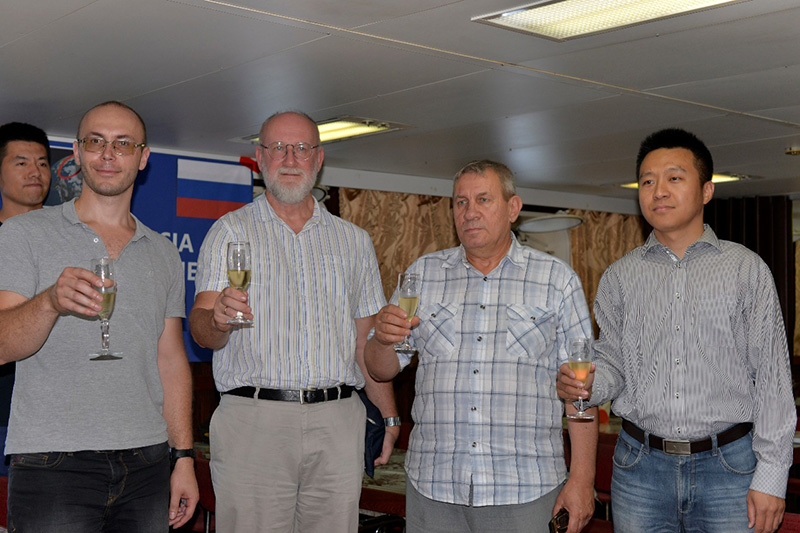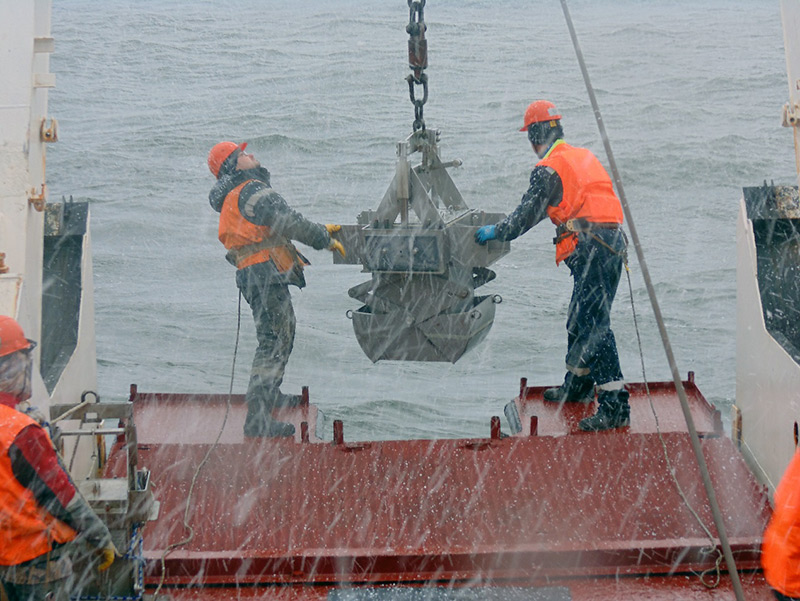2018 China-Russia joint cruise in the Arctic Ocean concludes successfully
2018 China-Russia joint cruise in the Arctic Ocean concludes successfully, and FIO's scientists return with flying colors
Upon the successful completion of expedition tasks in the Laptev Sea and other sea areas in the Arctic Ocean, the cruise team cruise returned to Petropavlovsk on the Kamchatka Peninsula of Russia on October 21, marking the fruitful conclusion of the 2018 China-Russia joint cruise in the Arctic Ocean. The cruise lasted 46 days and covered over 12,000 kilometers. A comprehensive survey involving marine geology, hydrometeorology, seawater chemistry, marine ecology, and other disciplines was carried out in the Laptev Sea, the East Siberian Sea, and the Chukchi Sea (the three key water areas of the Northeast Passage of the Arctic waters) where many important achievements were achieved.
The 2018 China-Russia joint cruise in the Arctic Ocean is supported by the "Transparent Ocean" and the "Aoshan Science and Technology Innovation Plan" projects of Pilot National Laboratory for Marine Science and Technology (Qingdao), and is organized and implemented by The First Institute of Oceanography (FIO), Ministry of Natural Resources (MNR) and Pacific Oceanological Institute (POI), Far Eastern Branch of the Russian Academy of Sciences (FEB RAS). Out of the 30 team members, there are 11 Chinese members, including five FIO members (Hu Limin, Huang Yuanhui, Chen Guangquan, Yu Yonggui, and Zhang Haitao), and the other six members from Ocean University of China and Yellow Sea Fisheries Research Institute, Chinese Academy of Fishery Sciences (CAFS). The chief scientists of the cruise are Dr. Hu Limin of FIO and Dr. Paulsen of POI, Russia.
Starting from the Vladivostok (Haishenwai), a far eastern city in Russia, on September 6, 2018, the team successively crossed the Sea of Japan, the Sea of Okhotsk and the Bering Sea, and, via the Bering Strait, came to the Chukchi Sea, the East Siberian Sea and the Laptev Sea in the Arctic Ocean for survey. On October 21, the cruise team returned to Petropavlovsk on the Kamchatka Peninsula after completing the scheduled tasks. The cruise has made the continental shelf surveys of China and Russia in the Arctic Ocean more comprehensive and systematic. Its major achievements are as follows:
1.The first marine geological survey in the Laptev Sea, an "ice factory" in the Arctic Ocean, has been carried out in China.
The Laptev Sea, located in the center of the Russian Arctic continental shelf, is significantly influenced by the inflow of the Arctic River--the Lena River. Interglacial lakes will be extensively developed in winter in the Laptev Sea, making it the most important "ice factory" in the Arctic Ocean, and also the most representative sea area to study the interaction between the Arctic continent and the ocean. It has received extensive concern from international academic community. The sediment samples and suspensions obtained from the Lena River estuary–continental shelf–continental slope–deep sea basin section in the Laptev Sea will be helpful to understand the sedimentary characteristics and environmental evolution of the sea area.
2.The hydrometeorological data along the key sea areas of "Northeast Passage" in the Arctic waters has been obtained.
The Arctic waters are among the areas with the highest frequency of sea fog in the world. Sea fog will affect the heat distribution of the Arctic sea–ice–air boundary layer, and pose a serious threat to the navigation safety of passing ships. In the context of global warming, the Arctic sea fog is also changing significantly. First-hand optical data have been obtained from observations of weather process of fog, snow and low clouds in the Arctic Northeast Passage.
3.The observed data of seawater chemistry and greenhouse gases along the continental shelf of East Siberia in the Arctic Ocean have been obtained systematically.
A radioisotope chemical tracer survey has been carried out for the first time along the continental shelf straddling the East Siberia (the Chukchi Sea–the East Siberia Sea–the Laptev Sea). Observations on the key sections of the Lena River estuary–continental shelf–continental slope–sea basin have been completed, and systematic radium isotope analysis data of sea water have been obtained. At the same time, large-scale, long-range and continuous greenhouse gas cruising observations across the North Pacific–the Subarctic region–the Arctic region have been carried out, which provide key data support for the scientific and rational assessment of reaction of the Arctic to global climate change.
4.Survey of plankton diversity on the continental shelf of East Siberia in the Arctic Ocean has been successfully carried out.
The team has completed the survey of marine plankton community composition and of microbial metabolism and diversity in the expedited sea areas, expanded the scope of survey of marine plankton in polar expedition in China, and systematically obtained samples of phytoplankton and zooplankton that can be used to provide basis for evaluation of the polar ecosystem structure and its changing trend in the context of rapid changes in the Arctic Ocean.
This is the second joint cruise in the Arctic Ocean organized by China and Russia since 2016. Before this cruise, in 2016, with the support of the Chinese Arctic and Antarctic Administration (CAA) and in cooperation with POI FEB RAS, FIO conducted the first joint cruise focusing on the East Siberian Sea and the Chukchi Sea, with the chief scientists being Anatoly Astakhov, professor of POI, and Shi Xuefa, research professor of FIO. In the first China-Russia joint cruise in the Arctic Ocean, Chinese scientists entered the Arctic Ocean area in the Russian region for scientific expedition for the first time, and has achieved a series of important results, making up for the insufficiency of previous Arctic expeditions of China. The second China-Russia joint cruise in the Arctic Ocean in 2018 has made the China-Russia continental shelf survey in the Arctic Ocean more comprehensive and systematic. The two scientific cruise have realized systematic cross-sectional surveys of the three key sea areas of the "Northeast Passage" in the Arctic, namely, the Laptev Sea, the East Siberian Sea and the Chukchi Sea. Such surveys not only provide a more in-depth and systematic understanding of the environmental evolution of the continental shelf of the Arctic Ocean, but also provide scientific support for the construction of the "Polar Silk Road".
At the sailing ceremony of the 2018 China-Russia joint cruise in the Arctic Ocean, Vyacheslav Lobanov, director of POI FEB RAS, spoke highly of the cruise. He said: "This is the second time that China and Russia have conducted a joint scientific cruise in the Arctic Ocean, and is also the sixth POI-FIO joint cruise since 2010." Yuri also said: "The number six is considered as an auspicious number in Russia; the implementation of this cruise is the result of the solidarity and cooperation between China and Russia. POI-FIO China-Russia Joint Research Center of Ocean and Climate (JRCOC) has contributed a lot in organizing this cruise. Both sides have overcome a series of difficulties and ensured the smooth departure of this cruise." For Arctic expedition, Yuri said: "Due to the impact of global climate change, marine environment changes and other issues in the Arctic are increasingly attracting the attention and concern of scientists around the globe. POI is willing to work with Chinese partners to strengthen research on the Arctic marine environment changes, and expects that both sides can make more achievements in research in the future."
POI FEB RAS is FIO's major partner in cooperation with Russia. Both sides have maintained good cooperation over the years. In September 2017, POI-FIO JRCOC was established, with POI and FIO being the major members, in Vladivostok where POI is located. This ushers a new phase for China-Russia cooperation in marine science and technology. In July 2018, Vyacheslav Lobanov, director of POI, visited FIO and fully exchanged views with Li Tiegang, director of FIO, on the opportunities and challenges facing China-Russia cooperation in ocean and polar research under the new situation. The two sides reached agreement on strengthening the construction of POI-FIO JRCOC. As the main cooperative platform for both sides and the first cooperative platform for marine scientific research, the joint research center is established in the context of deepening cooperation on scientific and technological innovations between China and Russia. Its establishment has promoted the cooperation between the two countries in Northwest Pacific, Arctic Ocean, and other sea areas, providing scientific support for construction of the "Polar Silk Road".
|








